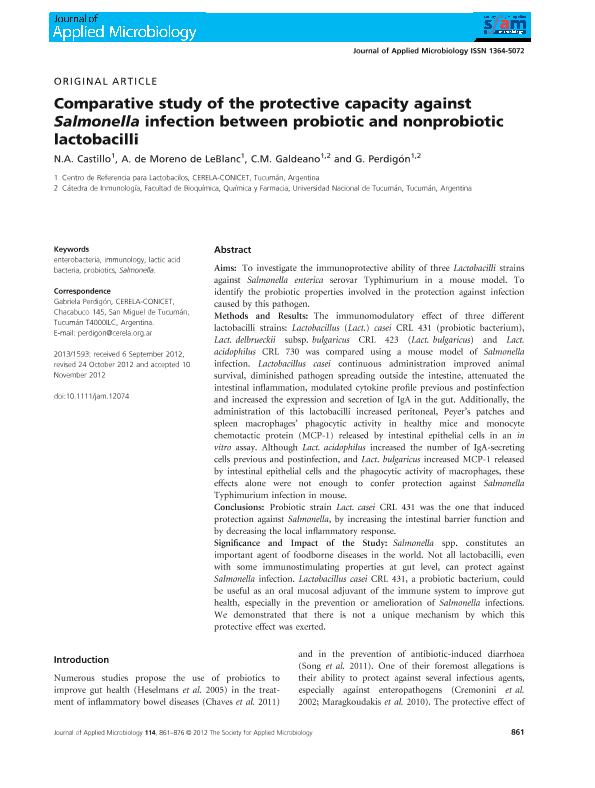Mostrar el registro sencillo del ítem
dc.contributor.author
Castillo, Natalia Alejandra

dc.contributor.author
de Moreno, Maria Alejandra

dc.contributor.author
Maldonado Galdeano, María Carolina

dc.contributor.author
Perdigon, Gabriela del Valle

dc.date.available
2015-08-24T15:30:13Z
dc.date.issued
2013-03
dc.identifier.citation
Castillo, Natalia Alejandra; de Moreno, Maria Alejandra; Maldonado Galdeano, María Carolina; Perdigon, Gabriela del Valle; Comparative study of the protective capacity against Salmonella infection between probiotic and nonprobiotic lactobacilli; Wiley Blackwell Publishing, Inc; Journal of Applied Microbiology; 114; 3; 3-2013; 861-876
dc.identifier.issn
1364-5072
dc.identifier.uri
http://hdl.handle.net/11336/1798
dc.description.abstract
Aims: To investigate the immunoprotective ability of three Lactobacilli strains against Salmonella enterica serovar Typhimurium in a mouse model. To identify the probiotic properties involved in the protection against infection caused by this pathogen. Methods and Results: The immunomodulatory effect of three different lactobacilli strains: Lactobacillus (Lact.) casei CRL 431 (probiotic bacterium), Lact. delbrueckii subsp. bulgaricus CRL 423 (Lact. bulgaricus) and Lact. acidophilus CRL 730 was compared using a mouse model of Salmonella infection. Lactobacillus casei continuous administration improved animal survival, diminished pathogen spreading outside the intestine, attenuated the intestinal inflammation, modulated cytokine profile previous and postinfection and increased the expression and secretion of IgA in the gut. Additionally, the administration of this lactobacilli increased peritoneal, Peyer’s patches and spleen macrophages’ phagocytic activity in healthy mice and monocyte chemotactic protein (MCP-1) released by intestinal epithelial cells in an in vitro assay. Although Lact. acidophilus increased the number of IgA-secreting cells previous and postinfection, and Lact. bulgaricus increased MCP-1 released by intestinal epithelial cells and the phagocytic activity of macrophages, these effects alone were not enough to confer protection against Salmonella Typhimurium infection in mouse. Conclusions: Probiotic strain Lact. casei CRL 431 was the one that induced protection against Salmonella, by increasing the intestinal barrier function and by decreasing the local inflammatory response. Significance and Impact of the Study: Salmonella spp. constitutes an important agent of foodborne diseases in the world. Not all lactobacilli, even with some immunostimulating properties at gut level, can protect against Salmonella infection. Lactobacillus casei CRL 431, a probiotic bacterium, could be useful as an oral mucosal adjuvant of the immune system to improve gut health, especially in the prevention or amelioration of Salmonella infections. We demonstrated that there is not a unique mechanism by which this protective effect was exerted.
dc.format
application/pdf
dc.language.iso
eng
dc.publisher
Wiley Blackwell Publishing, Inc

dc.rights
info:eu-repo/semantics/openAccess
dc.rights.uri
https://creativecommons.org/licenses/by-nc-sa/2.5/ar/
dc.subject
ENTEROBACTERIA
dc.subject
IMMUNOLOGY
dc.subject
LACTIC ACID BACTERIA
dc.subject
PROBIOTICS
dc.subject
SALMONELLA
dc.subject.classification
Inmunología

dc.subject.classification
Medicina Básica

dc.subject.classification
CIENCIAS MÉDICAS Y DE LA SALUD

dc.title
Comparative study of the protective capacity against Salmonella infection between probiotic and nonprobiotic lactobacilli
dc.type
info:eu-repo/semantics/article
dc.type
info:ar-repo/semantics/artículo
dc.type
info:eu-repo/semantics/publishedVersion
dc.date.updated
2016-03-30 10:35:44.97925-03
dc.journal.volume
114
dc.journal.number
3
dc.journal.pagination
861-876
dc.journal.pais
Reino Unido

dc.journal.ciudad
Londres
dc.description.fil
Fil: Castillo, Natalia Alejandra. Consejo Nacional de Investigaciones Científicas y Técnicas. Centro Científico Tecnológico Conicet - Tucumán. Centro de Referencia para Lactobacilos; Argentina
dc.description.fil
Fil: de Moreno, Maria Alejandra. Consejo Nacional de Investigaciones Científicas y Técnicas. Centro Científico Tecnológico Conicet - Tucumán. Centro de Referencia para Lactobacilos; Argentina
dc.description.fil
Fil: Maldonado Galdeano, María Carolina. Universidad Nacional de Tucuman. Facultad de Bioquimica, Quimica y Farmacia. Instituto de Microbiologia; Argentina. Consejo Nacional de Investigaciones Científicas y Técnicas. Centro Científico Tecnológico Conicet - Tucumán. Centro de Referencia para Lactobacilos; Argentina
dc.description.fil
Fil: Perdigon, Gabriela del Valle. Universidad Nacional de Tucuman. Facultad de Bioquimica, Quimica y Farmacia. Instituto de Microbiologia; Argentina. Consejo Nacional de Investigaciones Científicas y Técnicas. Centro Científico Tecnológico Conicet - Tucumán. Centro de Referencia para Lactobacilos; Argentina
dc.journal.title
Journal of Applied Microbiology

dc.relation.alternativeid
info:eu-repo/semantics/altIdentifier/doi/http://dx.doi.org/10.1111/jam.12074
dc.relation.alternativeid
info:eu-repo/semantics/altIdentifier/url/http://onlinelibrary.wiley.com/doi/10.1111/jam.12074
Archivos asociados
